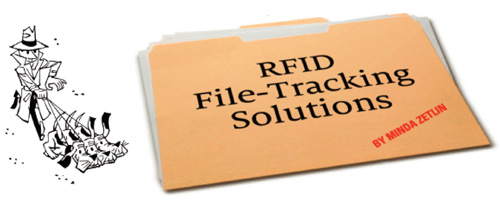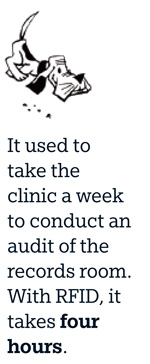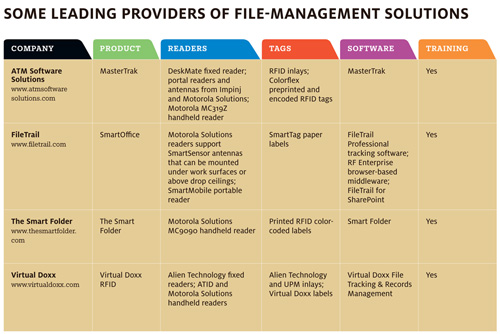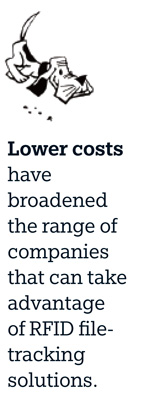An estimated one out of every 20 paper documents is lost in the workplace, according to research firm IDC, and office workers lose hundreds of hours each year searching for documents that have been misplaced. RFID solutions to address these problems were first introduced in 2000 by 3M, followed by similar offerings from FileTrail and other providers.
These solutions let companies and organizations automatically monitor file rooms and the movement of files within offices, so they can determine who checked out a file and when, as well as the file’s current location. The government agencies, law-enforcement departments, law offices, research libraries and universities that have adopted RFID file-tracking solutions report significant time-savings and reduced costs associated with searching for misplaced files.
Yet, in spite of technology advances that make RFID file-tracking solutions more effective, easier to deploy and less costly, adoption is stagnating. 3M no longer accepts new file-tracking business, though it continues to support its current customers. “We’re always evaluating different markets and businesses to make sure we can focus on the best opportunities,” says Skip Driessen, 3M’s global business manager. “We didn’t see it as a market that fits our future plans.” Instead, the company is focusing on its RFID solutions for libraries.
The problem is one of marketing, not value, says Michael Liard, VP of the AutoID practice at VDC Research. “I don’t know if it’s an issue of getting the message across,” he says. “Is it a lack of understanding of the technology or the cost savings? If you get it all down on paper, it just makes sense.”In fact, there’s never been a better time to consider an RFID file-tracking deployment, Liard says. “When RFID for file tracking was first introduced, there were no standards and price points were fairly high for passive smart labels,” he says. What’s more, existing technology could only read tags from roughly three feet away. Now, industry standards have evolved, and passive ultrahigh-frequency Gen 2 RFID tags are the norm. The cost of passive UHF tags has come down, and read ranges have increased.
Another stumbling block—aesthetics—is no longer an issue, Liard adds. “A lot of the readers for passive UHF tags have an industrial look and feel,” he explains. A law practice trying to project elegance, or a doctor’s office seeking a homey feel, might well have hesitated to put these devices in public areas. With longer read ranges, RFID antennas can be installed below flooring, above ceiling tiles and under desks, says Darrell Mervau, CEO of FileTrail.
RFID fixed readers such as the DeskMate, used in Engineered Data Products’ ATM Software Solutions products, are small and sleek enough to fit into any office design, says Jeff Gibson, the firm’s product manager. The DeskMate measures 5.5 by 4 by 1.3 inches.
Longer read distances also reduce or remove still another common barrier to RFID adoption: the need for office personnel to change the way they do their jobs. People using the files don’t have to change their behavior at all, Mervau says. They merely pick up the files and transport them around as they normally would, and the RFID system silently tracks the location of each one.How big must a company be for an RFID file-tracking solution to be cost-effective? It’s not so much the size of the company as the number of files being tracked—and the value attached to those files. “Our smallest deployment is with a company of 50 employees,” Mervau says. But, he adds, it probably isn’t worthwhile for truly small firms, with only 25 employees and a couple of thousand files.
Financial and legal firms, lenders, insurance companies and medical clinics are among the companies at a crossroads in terms of managing files, Gibson says. They’re determining whether to go electronic or stay with paper. Those that decide to stay with paper are considering RFID file tracking, he adds, as it becomes a more accepted technology.
Here’s what else you need to know to determine whether your company would benefit from an RFID file-tracking solution.
Typically, RFID file-tracking solutions include passive UHF RFID tags or inlays to identify files, and fixed and portable RFID readers to automatically monitor documents in file rooms and offices. Companies that are tracking files with a bar-code system can encode an RFID tag with the same information. A conversion station is set up with a fixed RFID reader and a bar-code scanner, ATM’s Gibson says. A user attaches an RFID label to a folder, hits the “encode” button and scans the bar-code label on the folder. “Then, they have a file that carries both,” he says.FileTrail’s Mervau agrees that the transition from bar codes to RFID is relatively easy. “We convert the existing bar-code number when we do the data migration into the RFID system,” he says. “We’ve had customers with 80,000 folders to convert, and they had employees converting 200 folders an hour. They scan the bar code, scan the RFID tag, and it’s done.”
An unattended records room is equipped with a fixed reader to automatically monitor files. ATM typically sets up a check-in/check-out station, with a DeskMate plugged into a computer’s USB port. It can read 10 to 20 folders at a time. FileTrail installs an RFID portal that can read multiple files—including up to 50 files stacked in a nonmetal shopping cart—as users walk through the door.
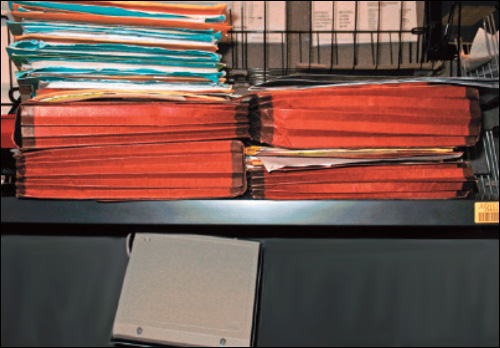
To ensure a file doesn’t leave a records room without being checked out, an RFID reader can be installed in the ceiling, with antennas inside and outside the file-room door. The tracking software can be set to trigger an alert or alarm if an employee removes a file without checking it out. For additional security, employees can be issued RFID identification badges, so the file is associated with the employee who checked it out.
Checking in differs from checking out because it’s location-based rather than keyed to an individual, Gibson says. “When you check something out, you want to know who has it. When you check it in, you want to know where it is,” he says. “If I have 15 files that are going to a specific doctor, I go to the portal, select that doctor, wave all 15 folders at the reader, and it checks them all out. You can see the time savings over bar coding, where I’d have to individually scan all 15.”To monitor files as they circulate within an office, FileTrail installs RFID antennas, called SmartSensors, above ceiling tiles, in doorways or under desks at most deployments, Mervau says. The antennas are connected by coaxial cable to fixed readers up to 40 feet away. ATM usually equips each desk or work area with a DeskMate RFID reader.
As with the records room, the tracking software can be set to trigger an alarm or send a text message to a manager if an employee who doesn’t have permission leaves the premises with a folder. Another option is to have a camera at the exit automatically take a picture, so the person carrying the file can be identified if the need arises. Still other customers choose to remind employees in a not-so-gentle fashion not to carry out files. “We even have it where a big light spins around flashing and there’s a siren noise so you’ll be embarrassed,” Mervau says.
Click here to view a larger version of the above table.
To locate a misplaced file, an employee can use a handheld RFID reader set in what’s often referred to as “Geiger counter” mode; the reader can locate a file within 20 feet. As the user nears the desired file, the reader’s tone and status-bar display get louder and larger, respectively.
The Geiger counter feature can also search for a list of files. One of ATM’s medical clients, for example, forbids physicians from keeping a file in their offices for more than 15 days. ATM’s MasterTrak software makes enforcing that rule much easier. “Each day, an operator can download a list of overdue files and then go to each physician’s office,” Gibson says. The Geiger counter will activate whenever it finds any of those files.A handheld reader also enables companies to conduct audits in record rooms. A group medical practice in Texas with 30 physicians and some 320,000 files, recently adopted the ATM Software Solution, Gibson says. At times, each physician has up to 3,000 folders in his or her office. The ability to know the location of each folder increases productivity, as well as patient confidence. It used to take the clinic a week to conduct an audit of the records room, Gibson says. With RFID, it takes four hours—a big time-saver, considering the clinic conducts an audit every 15 days, he adds.
Companies that are using Microsoft’s SharePoint, a Web application to manage documents, can integrate it with FileTrail for SharePoint, a program that adds physical-records tracking and management capability (see Black Elk Uses FileTrail-SharePoint Solution to Track All Its Documents, Physical and Electronic). “So many companies are moving to SharePoint to manage all their information assets,” Mervau says. “We’re able to provide physical-records management, where users can assure compliance around those assets, both electronic and physical.”
From within SharePoint, users can ascertain the whereabouts of a file, put a hold on it or request it, or send information to a central storage location to compile a box of desired files. The data resides in SharePoint, and users see that data as part of their existing libraries. “You can see any item in a single view,” Mervau says.
Lower costs have broadened the range of companies that can take advantage of RFID file-tracking solutions. “In the early days, it was 40 or 50 cents for a basic label,” Liard says. “Now it’s around 25 cents.” FileTrail’s bar-coded RFID labels cost 25 cents each. ATM’s inlays cost 24 cents each, and its RFID tags cost 30 cents each.A complete ATM solution, including fixed and mobile RFID readers, ranges from $5,000 to $20,000, depending on how many files must be tagged. It usually takes one to two days to deploy the solution, Gibson says. “We discuss work flow to improve processes in advance, and we can configure the software remotely,” he adds.
FileTrail’s ExpressRFID is a packaged solution designed to make it economical to get started with a small RFID file-tracking deployment. It includes a handheld reader, 1,000 labels, software and training, and costs $14,995. “It gets people to understand RFID and see its value,” Mervau says. “Most people who use it don’t have any system in place at all, so anything will be an improvement.” And once they’ve seen what RFID can do, they can easily expand from there. Depending on size, a FileTrail deployment can take eight weeks to six months to complete, he adds.
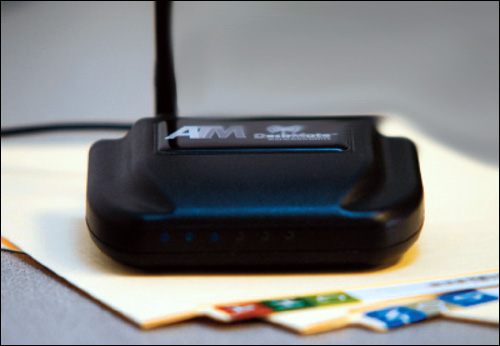
In the future, RFID file tracking may become less expensive or bring more options and capabilities. “This is part of printed electronics, and that’s a technological area that continues to expand,” Liard says. In time, he speculates, end users may be able to print not only labels or documents that contain tags but also the tags themselves, perhaps using some form of specialized paper.
There’s no need to wait until then, though, to give RFID file tracking serious consideration. “This solution’s not going to go away,” Liard says. “The industry has just been challenged with communicating the benefits. It’s elegant, it’s secure and it will fit into your office environment. It just makes sense.”

